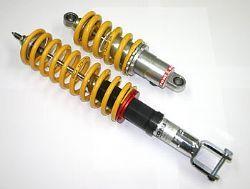By Jenny Baker It is important to maintain a car’s suspension system well and do replacements in time. A faulty suspension not only makes for an uncomfortable ride and extra maintenance costs, it can result in loss of road holding and control and endanger the lives of the driver and occupants of a car. To maintain control when the vehicle steers, drives, brakes, and turns the car’s tyres need to press firmly on the road at all times. This becomes even more urgent in emergency situations. According to Stocks Divisional Manager Grant Scheuber, just one worn shock absorber means the driver may need up to 2.6 metres longer to stop – perhaps the difference between stopping safely or crashing. Scheuber says the average age New Zealand’s in service fleet is 12 years old. “It’s obvious there will be vehicles needing suspension service. Customers however don’t always readily identify the need for suspension part replacements. The degrade in ride quality is often so gradual they’ve become accustomed to it,” he says. He believes workshop technicians have a duty of care to identify worn suspension systems. Technicians must explain to customers how the suspension system parts work together to be effective and ensure their safety. They must understand although springs and shock absorbers or struts are the main parts, it is important that other parts, including ball joints, tie rod ends, and suspension bushes are in good order. “Customers must be advised to look out for unusual or increased tyre tread wear, shocks that leak fluid, and a car that does not handle properly around corners, wanders when driving, or dips forward when braking. They should ensure ball joints are inspected at least twice a year and the system is lubricated with each oil change,” he comments. Traditional methods for determining shock replacement are subjective. Physical damage is often the first reason for shock absorber replacement. Visual clues are pitted, bent, or broken rods; a severely dented dust shield that restricts shock movement; severe fluid leakage from shocks; worn or missing bushings; and abnormally worn or cupped tires. “Without visual damage, it’s difficult to quantify the reasons for parts replacement to customers. There are however a range of products and processes that can be used to determine the shock absorbers’ performance. These range from the subjective ‘bounce test’ and data-recording units used in conjunction with it that generate a printout of comparative performance, to in-ground units - usually a built-in feature of brake testing units - that perform accurate and repeatable tests,” Scheuber comments. He says apart from the safety issues, valid shock and strut work is also very profitable especially considering associated services that might be required, such as alignments after strut replacement. In addition, if the automotive technician updates the shock absorbers on a customer’s vehicle there may well be an opportunity to update the springs as well: “Remember aftermarket coil springs are not only for the performance lowered market. “For those requiring extra loading capacity there’s a range of standard height increased rate springs available…very useful for Japanese imported vehicles that will probably carry heavier loads of goods and people here in New Zealand. “These customers will be better off in the long run with a complete suspension package rather than half a job. And you can get everything you need from one phone call to STOCKS,” he says.
Keep the suspense going
Keep the suspense going
Motorsport
Thursday, 14 August 2008






